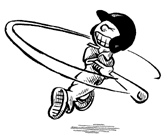
|
Physics and Acoustics of Baseball & Softball Bats
Daniel A. Russell, Ph.D. Applied Physics, Kettering University, Flint, MI 48504-4898 The contents of this page are ©2007 Daniel A. Russell | 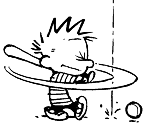
|

|
Physics and Acoustics of Baseball & Softball Bats
Daniel A. Russell, Ph.D. Applied Physics, Kettering University, Flint, MI 48504-4898 The contents of this page are ©2007 Daniel A. Russell | 
|


In this article I will elaborate on the differences between metal and wood bats, with an explanation of how those differences might allow a metal bat to perform better than wood. I will also attempt to review the paucity of published experimental data comparing the performance of metal and wood bats, specifically in terms of how fast they both types of bats hit balls. The current version of this article represents a major overhaul and re-write in order to clarify several key issues that have apparently caused a significant amount of misunderstanding. The previous version of this article was used (ignorantly) as "scientific proof" by several politicians arguing that today's metal bats pose an inherent danger to pitchers and infielders to such an alarming extent that they should be banned.
Metal bats were first allowed in NCAA college baseball, youth baseball, and adult amateur softball in 1974, and they quickly dominated both sports. Back in the mid 1970's the primary advantage of metal bats was that they didn't break, and a team could use two or three bats for an entire season at a significantly lower cost compared to the 60 or so wood bats that kept breaking.[REF] During the last 30 years there have been significant advances in aluminum alloys which have allowed bat manufacturers to design bats that not are not only more durable than wood, but which also perform noticeably better than wood. The majority of current metal baseball bats have hollow barrels of single-walled aluminum. However, softball bats come in many varieties: single-walled aluminum, titanium (illegal since 1993), double-walled aluminum, composite, multi-walled composites, aluminum and composite hybrids. Both baseball and softball bats are also available in two-piece configurations with metal or composite barrels joined to composite handles with varying degrees of handle flex. Every year new designs and models are introduced, and marketing materials loudly claim that each new model is better than competitor's models and better than previous year models. Each new bat model is touted to have a wider sweet spot, more power, better feel, higher performance, etc., (although many of these claims are simply marketing tools designed to entice people to buy a product). The general perception is that metal bats hit balls much faster than wood, and that is the primary reason they perform better - though this perception is not entirely accurate. There are many people who decry the use of metal bats, out of concern for the integrity of the game, out of a desire to improve player development and control the balance between offense and defense, or because they prefer the satisfying "crack" of a wood bat to the unsavory "ping" of metal bat.
In recent years the metal-vs-wood issue has become quite a controversial topic because of the claim that metal bats pose a significant safety risk to young players. Claims that higher batted ball speeds from metal bats put pitchers and infielders at higher risk for injury have led to calls for restrictions on bat performance and to outright banning metal bats in some regions. The extremely unfortunate and tragic (but extremely rare) occurrences of pitchers being severely injured or even killed by hit balls have captured national media attention, and the emotional outpouring of opinions has lead to heated arguments at times resulting in threats of lawsuits between bat manufacturers, safety watch organizations, and sports regulatory groups, or legislative action to ban the use of metal bats. In the Fall of 2002 the Massachusetts Interscholastic Athletic Association considered banning the use of aluminum bats in high school tournament play for 2003 and for all high school games in 2004, though they ended up not passing the ban. In 2006 the North Dakota state legislature did pass a ban on metal bats in high school baseball citing as reasons the problems of aluminum bat durability in colder weather and the cost of replacing dented metal bats every year, a desire to restore the integrity of the game of baseball as played with wood (in terms of batting averages, pitching, and base running), a desire to improve the development of pitchers and batters by returning to wood, as well as some concerns about the potential safety of pitchers and infielders. In 2006, after a pitcher was severely injured by a hit ball, the state of Montana considered banning bats - but ended up rejecting the ban. In March 2007 the New York City Council passed legislation banning metal bats for high school play, claiming a "mountain of evidence" showing that metal bats hit balls at excessively dangerous speeds and pose a significant safety risk to pitchers and infielders. The NY City mayor vetoed the ban, but the council may have enough votes to overturn the veto and pass the bill anyway.
Much of the controversy over the issue of metal versus wood bats is the claim that aluminum bats are inherently more dangerous than wood bats because of the extremely high speeds with which metal bats supposedly hit balls, although this position has been disputed. In this article I wish to first examine the research that has been published comparing the performance of wood and aluminum bats to see whether or not there is any actual scientific evidence to support the claim that metal bats hit balls faster than wood bats do. Then I will describe several of the actual advantages that using a metal bat provides a hitter.
[1] Metal bats can be swung with greater speed and controlBecause the barrel of a metal or composite bat is hollow, the distribution of mass along the length of a metal bat is considerably different than it is for a solid wood bat. Specifically, the difference shows up in the location of the center-of-mass (CM) - otherwise known as the balance point. The closer the balance point is to the handle of the bat, the easier it is to swing the bat. The bat industry calls this the "swing weight" of a bat, and the technical physics term is the moment-of-inertia. Several comprehensive field studies for for players swinging baseball bats[5,6] and softball bats[7,8] at pitched balls have concluded that the speed with which a bat can be swung is directly related to the moment-of-inertia (MOI) of the bat. The field test experimental data for bat swing speed can be fit rather well to an equation, so that if we know the moment-of-inertia of the bat we can predict the speed with which that bat can be swung. The moments-of-inertia and the resulting swing speed equations are different for baseball and softball.The advantage of a lower MOI bat is that it can be swung with greater speed and greater control. This means that a batter can wait a fraction of a second longer before committing to a swing. At the college level this might mean a batter can watch the ball travel about 6 feet further before deciding to swing, which might be enough to be able to better determine whether the approaching pitched ball is a fastball or a curve ball. Having greater control of the bat during the swing would allow a batter to make contact with the ball more often - resulting in a higher batting average. The ability to put a ball into play more often leads to more base runners and more runs scored. Statistical data from several wood-bat leagues[NCAA-stats] shows that batting averages and home run production drops noticeably when players switch from metal bats to wood bats. A common misunderstanding is the assumption that lower MOI metal bats hit balls faster because these bats can be swung faster. It is true that batted-ball speed depends directly on the bat-swing speed. If all other things (ball characteristics, bat weight and MOI) remain the same then increasing the bat-swing speed will result in balls being hit farther. However, while lowering the bat MOI does allow a player to swing the bat faster, the lower MOI of the bat also reduces the effectiveness of the collision between bat and ball. The gain in hit ball speed due to higher bat-swing speed is almost exactly cancelled out by the decrease in collision efficiency due to the lower MOI of the bat. This can be shown theoretically, but it has also been verified experimentally for both baseball and softball bats. A lower MOI metal bat can be swung faster and with greater control and might enable a batter to put the ball into play more frequently - but a lower MOI bat will not hit balls any faster. The trade-off between higher bat speed and lower collision efficienty is exactly the reason that a corked wood bat provides little actual advantage to a hitter.
|

|
|
[2] The handles of metal bats don't break The durability of metal bats, and the cost advantage this provided back in the 1970's, is the primary reason that metal bats were adopted in the first place. Wood bats - especially the thin handled ash bats used by a majority of today's players - have a tendency to break for impacts near the handle (inside pitches). While there are historical exceptions (Hall of Famer Joe Sewell used a single 40-ounce hickory bat painted black and nicknamed "Black Betsy" during his entire career from 1920-1933) today's professional players typically go through several dozen thin handled ash bats each during a typical baseball season.[11] Similarly, back in the 1970's college teams that used wood bats often broke more than two dozen during a season. Because of shortages of quality wood, and the higher cost of good quality wood bats, most college teams had completely switched over to aluminum bats by the mid 1980's. Most college teams can get by with 12 aluminum bats per season, as opposed to more than 5 dozen wood bats per season.[12] Back in the 1970's and 1980's it was cost advantageous to use a dozen metal bats instead of 5 dozen wood bats. With the cost of a good quality metal bat currently around $300 this cost advantage may no longer hold true. However, good quality wood bats are not easy to obtain either. The best wood is reserved for Major League Baseball players, with much lesser quality wood used to produce youth and adult baseball bats for amateurs. Minor league players often complain about the lack of good quality wood and the difficulty of finding a really good wood bat. Aluminum is much stronger than ash wood, and the handle of an aluminum bat is a thin cylindrical tube with reasonably thick walls (thicker than the barrel portion). As such, the bat handle is very strong and will not break. The barrel, where the walls are thinner, may dent - or even crack* if the walls are too thin, the but the handle will not break. It can be effectively argued that because aluminum handles don't break, this provides a distinct advantage to a hitter. An inside pitch, which would break a wood bat often resulting in an easy out, can be hit rather strongly with an aluminum bat resulting in a base hit. Some have argued that the fact that aluminum bats don't break has a noticeable impact on the quality of pitching in baseball. Because college players use aluminum bats, they can hit inside pitches for base hits. As a result, fewer and fewer younger professional pitchers throw inside pitches than used to be the norm in years past. They learn while playing in high-school and college that inside pitches get hit for runs. Likewise hitters often find it to be considerably difficult to make the change from aluminum to wood, especially when dealing with inside pitches. *It is not, however, impossible for aluminum bats to break - but usually when they do it is not the handle but the barrel that breaks. While watching ESPN Sports Center one night towards the end of May 2003, I saw a clip from a college game in which a metal bat shattered leaving the batter holding the handle and half the barrel while the other half of the barrel flew out and landed next to the shortstop. Apparently a player in the 2003 Women's College Softball World Series also broke an aluminum bat. So, it can happen. |
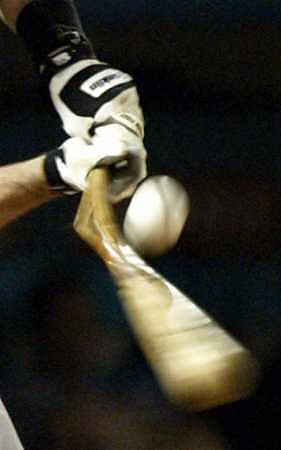 
| |
[3] Metal bats are more forgiving for impacts away from the sweet spotThis advantage is a little tougher to scientifically validate - partly because the "sweet spot" is a term used to mean several different things relating to both the perception of feel and the measure of performance. The location on the bat where an impact results in the least sting is not always the same as the location where the ball comes off the bat with the greatest speed. Many of the marketing ploys regarding the size of the sweet spot often refer to the perception that a given bat is more forgiving (i.e.., balls still go far, and bat feels good) for impacts away from the sweet spot.Crisco and Greenwald defined the sweet spot as the range of locations on the bat barrel for which the highest 10% of batted ball speeds were obtained. They found that the width of the sweet spot was nearly the same for all bats (wood and metal) bats tested. One of the principle conclusions of the Crisco-Greenwald study is that for metal and wood bats with similarly sized sweet spots, the batted ball speed will be higher for the metal bat.[4] But, their data does not show a difference in the size of the sweet spot for wood and aluminum bats. However, as the data in Figure 5 shows, for an impact outside of the sweet spot - especially towards the middle of the bat - the batted ball speeds for metal bats are significantly higher than for wood. |
 Figure 5. Width of the sweet spot for metal and wood bats is the same. But, batted ball speed is higher with metal bats for impacts away from the sweet spot. |
|
[4] Metal bats have a "trampoline effect" When a ball hits a wood bat, it compresses to nearly half its original diameter, losing up to 75% of its initial energy to internal friction forces during this compression. In a hollow bat, however, the bat barrel compresses somewhat like a spring, when the ball impacts it. This means that the ball is not compressed as much and therefore loses less energy to internal friction forces. Furthermore, most of the energy temporarily stored in the barrel is returned to the ball, and the energy which is lost in the bat compression is a small fraction of what would have been lost in the ball if it had impacted a wood bat instead. The physics behind the trampoline effect is somewhat complex, though a simple model can be used to illustrate the main concepts, as explained elsewhere on this website. What I want to do here is discuss experimental evidence that a trampoline effect really does seem to be partly responsible for improvement in performance of aluminum bats over wood. Again, the only published study to-date which offers evidence of an enhancement in performance for metal bats due to an elastic property of the bat is the Crisco-Greenwald study. Figure 3 compares batted ball speeds for balls hit with a wood bat (orange dots) and the highest performing metal bat (blue dots) used in their study. The horizontal axis (Impact Speed) represents the swing speed of the bat. Plotting the data this way normalizes the results so as to remove the effect of different moments-of-inertia (see reason [1]). The figure shows that for a given swing speed, the metal bat can potentially hit the ball 5-7mph faster than the wood bat. This can be explained if the metal bat has a trampoline effect which returns more of the energy to the ball. Crisco & Greenwald were only able to conclude that an "inherent elastic property" of the bat was most likely present to explain the difference in batted- ball speeds shown in Figure 3. They were not able to explain differences in this effect between the five metal bats they tested, and so could not explain how the trampoline effect improves performance. During the Summer of 2004 I was granted access to the five metal bats used in their batting cage study. I measured the frequency of the mode of vibration in the barrel, called the hoop mode, which gives rise to the trampoline effect. From my analysis of various hollow softball bats I have shown that the frequency of the hoop mode correlates pretty well with performance.[10] All other bat parameters being equal, the bat with the lowest hoop frequency will have the highest performance. Figure 4 shows the Bat-Ball Coefficient-of-Restitution (which measures the combined elastic properties of the bat-ball system) as a function of hoop frequency. The solid curve is a theoretical prediction from my simple mass-spring model of the trampoline effect, and the data points represent the measured BBCOR values (extracted from the original field study data by my friend and colleague Alan Nathan) for the five metal bats used in the Crisco-Greenwald batting cage study. The plot clearly shows that the higher performing bats have a lower hoop frequency, which indicates that the simple mass-spring model of the trampoline effect captures the essential physics. |
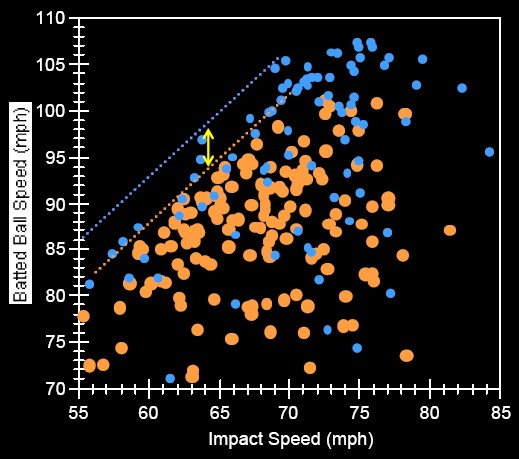 Figure 3. Evidence of an enhancement in performance due to an "inherent elastic property" of the bat. Orange dots are for a wood bat, and blue dots are for a high performance metal bat.
|
[5] Metal bats can be designed to hit balls faster than wood batsCAN does not mean always do.Bat performance is regulated. Scatter of batted-ball speeds. Refer to article "How Much Faster do Metal and/or composite bats hit balls compared to wood" |
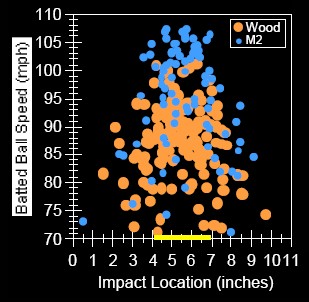 Figure 5. Width of the sweet spot for metal and wood bats is the same. But, batted ball speed is higher with metal bats for impacts away from the sweet spot. |
References
[5] G. Fleisig, N. Zheng, D. Stodden, and J. Andrews, "Relationship between bat mass properties and bat velocity," Sports Engineering, 5(1), 1-8 (2002).
[6] J. Clutter and K. Koenig, "The effect of baseball bat properties on swing speed," in: Proceedings of the 4th meeting of the American Society of Mechanical Engineers; Bioengineering Division, Edited by V. Goel, R. Spilker, G. Atheshian, and L. Soslowsky, Big Sky, MT, June (1999), 629-630.
[7] L. Smith, J. Broker, and A. Nathan, "A Study of Softball Player Swing Speed," in: Sports Dynamics Discovery and Application, Edited by A. Subic, P. Trivailo, and F. Alam, (RMIT University, Melbourne Australia, 2003), 12-17.
[8] K. Koenig, N. Mitchel, T. Hannigan, and J. Clutter, "The influence of moment of inertia on baseball/softball bat swing speed," Sports Engineering, 7(2), 105-118 (2004).
[1] F.O. Bryant, L.N. Burkett, S.S. Chen, G.S. Krahenbuhl, and P. Lu, "Dynamic and performance characteristics of baseball bats," Research Quarterly,
48, 505-510, (1977).
[2] A.S. Weyrich, S.P. Messier, B.S. Ruchmann, and M.J. Berry, "Effects of bat composition, grip firmness, and impact location on postimpact ball velocity," Med. Sci. Sports Exerc., 21, 199-205 (1989)
[3] L.R. Hester and K. Koenig, "Performance measurement of baseball bats," Journal of the Mississippi Academy of the Sciences, 38(2), 7-10 (1993)
[4] J.J. Crisco and R.W. Greenwald, "Metal baseball bats can outperform wood bats with a similar `sweet spot'," Proceedings of the 24th Annual Meeting, American Society of Biomechanics. Chicago, IL. July 19-22 (2000).
[5] R.M. Greenwald R.M., L.H. Penna , and J.J. Crisco,"Differences in Batted Ball Speed with Wood and Aluminum Baseball Bats: A Batting Cage Study," J. Appl. Biomech., 17, 241-252 (2001).
[6] J.J. Crisco, R.M. Greenwald, J.D. Blume, and L.H. Penna, "Batting performance of wood and metal baseball bats," Med. Sci. Sports Exerc., 34(10), 1675-1684 (2002)
[7] Smith, L, Broker, J, Nathan, A, “A Study of Softball Player Swing Speed,” Sports Dynamics Discovery and Application, Edited by A. Subic, P. Trivailo, and F. Alam, RMIT University, Melbourne Australia, pp. 12-17 (2003)
[8] G.S. Fleisig, N. Zheng, D.F. Stodden and J.R. Andrews, "Relationship between bat mass properties and bat velocity," Sports Eng., 5, 1-8 (2002)
[9] J.J. Crisco and R.W. Greenwald, "Batted Ball Speed as a Function of Swing Speed and Impact Location," presented at the 2001 Annual SGMA Baseball/Softball Industry Meeting, Chicago, IL (2001).
[10] D.A. Russell, " "Hoop frequency as a predictor of performance for softball bats," Engineering of Sport 5, Vol. 2, pp. 641-647 (International Sports Engineering Association, 2004).
[11] Phil Patton, "Wooden bats still reign supreme at the old ball game," Smithsonian, 15, 152-165 (1990)
[12] Julavrits, "Bat Rap," Sport, 90(6), 26 (June, 1999)
[13] Nicholas J. Giordiano, Computational Physics, pp. 28-38, (Prentice Hall, 1997)
[14] Robert K. Adair, The Physics of Baseball, 3rd Ed., (HarperCollins, 2002)